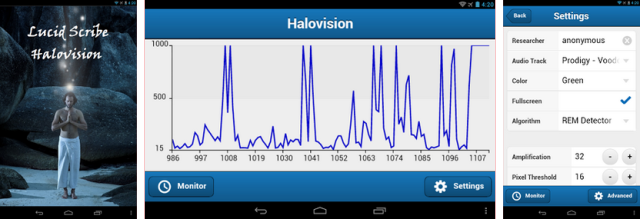[Michael] from Lucidcode is at it again, this time with an Android app called Halovision.
In case you don’t remember, this is the guy who has been working on the Lucid Scribe Project, with the end goal of communicating from inside your dreams! Here’s the basic gist of it. If we can use a sensor to detect REM (rapid eye movement) or body movement during sleep, we can tell if we’re dreaming — then it’s just a matter of using an audible cue to inform the sleeper of the dream, so they can take control and become lucid.
The first way they did this was by using commercial EEG headsets to detect REM. We covered a hack on modifying one so it would be more comfortable to wear at night, but what is really exciting is [Michael’s] new app, Halovision — No EEG required
It’s an Android app that uses the camera to detect movement during sleep, and it is only the first plugin planned for Lucid Scribe. The algorithm is still in its experimental stages, but it is at least somewhat functional at this time. They note it’ll only work for day-time naps or with a bright night light, but this could be easily solved with an IR webcam and a few IR LEDs.
It will be interesting to see where this all goes, has anyone else been following or participating in Lucid Scribe?
















Strap a phone to your hand and gather data from gyro sensor.
or accelerometer, whatever is present
or existing wireless sports tracker. Bear with yourself while getting used to it.
Dude, your hand is paralized during sleep.
Special delivery from OP:
– http://lucidcode.com/category/software/lucid-scribe-android/fild/
– http://lucidcode.com/category/software/lucid-scribe-ios/fild-lucid-scribe-ios/
Don’t strap it, just tap it!
Using video data to record eye movements is technically VOG — video-oculography Ref: https://en.wikipedia.org/wiki/Video-oculography.
I’ll admit that I don’t know that much about measuring eye movements while a patient is asleep, but how much do the eyelids and eyelashes obscure the ability to accurately track what one’s eyes are doing? Or does the system assume that the eyelids also “flutter” (for a lack of a better term) rapdily during REM sleep and use that for its model? I realize this isn’t medical grade research that’s being done, but I would question how reliable VOG really is for this application.
I’ve used a medical-grade VOG system before, and yes, IR lighting is great for tracking the eyes in the dark. You do, however, have to be careful about ambient lighting conditions when using IR for tracking eye movements, because reflections can cause incorrect returns when trying to track a moving pupil.
The “Sleep as Android” app has something similar to this, where it detects deep sleep by the lowered activity of the body – usually a person moves a bit to avoid bedsores, but when we dream, the body is partly anesthetized, such that we don’t hurt ourselves by reacting upon the dream. The app senses this using the phones inertial sensors, and can play a sound to notify the user before entering deep sleep. The phone doesn’t even have to be strapped to the user, just place it on the bed, and it automatically tunes the sensors.
I’m not affiliated with the development of the app in any way, this is not meant as a commercial, just an inspiration :-)
Dr. Monroe of the Monroe Institute worked on this very subject almost 30 years ago. Ive seen Lucid Dreaming Goggles on sale before on the internet, where sensors detect REM and flash a red light (visual cue instead of auditory) and most report seeing either red or a rainbow spectrum to remind them they are dreaming. Dr. Monroe was using bi-neural sound wave technology, whereby differing Hz levels are played in each ear so that the sound waves cancel each other out and is only left with a small remainder that cannot be physically heard but the brain perceives, and this level is that which the brain functions in REM, and has done this to induce sleep and altered states and came out with many recordings for meditation, sleep, and focus. He has had many experiences with Out of Body trips and has succeeded in inducing these states.
Assuming you meant “experientially heard”, my question is what level are you talking about when comparing the residual sound-wave impulse left from the cancelation and the “state” level in which, as you say, the brain is operating during the REM period? More specifically – what kind of the state you are referring to when describing the brain in the REM?